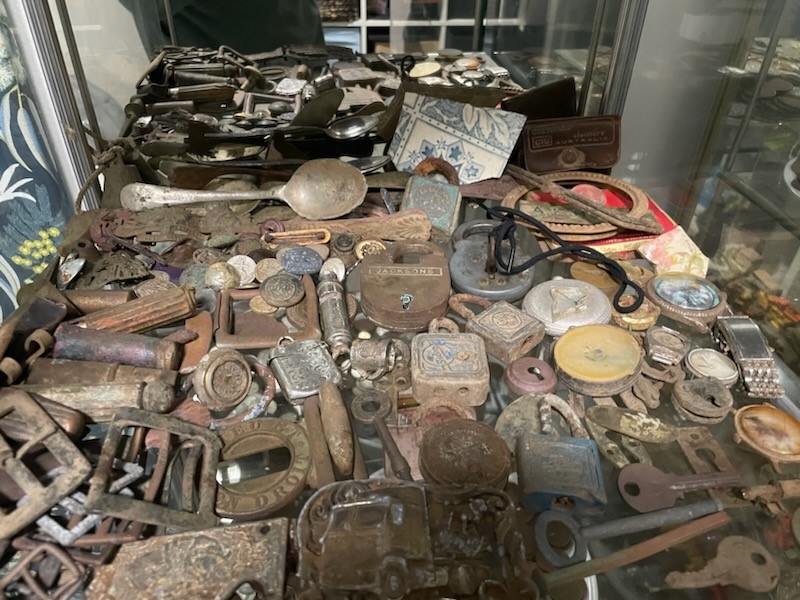A massive haul of pre-decimal coins, old silver pocket watches, medallions and more has been dug up by Canberra metal detectorist (and former Federal Agent), Camille Chicheportiche, but it’s not gold she’s hunting – it’s history.
For the past four years, Camille heads out weekly armed with one of the best detectors on the market (Manticore), listening intently to the detector’s beeps and blips in her quest to unearth Canberra’s buried history.
Her prized find so far is an 1873 trinket made of solid silver French francs welded together with a silver chain, which Camille researched and discovered was a match strike and cigar cutter.
“For me, they’re valuable because of the historical significance and that’s somebody’s story,” Camille said. “I just keep it alive a little bit longer.”
Camille displays her vast archaeological collection in a glass cabinet, which heaves under the weight of old toy cars, military items, padlocks, pennies, 1930s tokens, bullets, buckles, buttons and jewellery (even a Victory Medallion from World War II given to school children).
Some of her most fascinating finds are “trench art”, trinkets made by soldiers from whatever metal they could find. Diggers would transform scrap metal into airplanes, ships and even a moulded slouch hat from a melted-down copper coin.
Camille’s oldest coin, which places her in the detector community’s exclusive “1700 club”, is a 1799 George III UK half penny.

“I’m completely addicted because you just never know what you’re going to find,” she said. “The thrill of what’s going to be in the next hole.”
Metal detecting is mostly a solo pursuit for Camille, who spends hours each week scouring Canberra’s historic older suburbs (with permission). What originally started in her suburban backyard as a hobby (finding pre-decimal coins and cap guns) has transformed into an earnest quest for forgotten history.
“The skill of the detectorist is knowing how to set the detector to suit the conditions and then actually listening to the language of the detector,” Camille said. “I know it sounds funny but the detector actually speaks to you in tones and beeps and target IDs (numbers) pop up and you need to know how to read it.”
Metal detecting also has an added health benefit, with Camille describing it as a “Zen place where you can just seriously focus on the tones and swinging slowly”.
“It’s like a Tai Chi sort of motion,” she said. “You don’t swing fast and you can either grid an area out or you can just randomly walk around.”
While many metal detectorists avoid rubbish dumps, Camille is drawn to them – especially old bottle dumps.
“The rubbish dumps are where you find everything like non-metal items such as old broken crockery with ornate designs. Just yesterday I found some silver florins melted down in a fire.”
Sometimes Camille also ventures into the water at the NSW south coast, as her detector can go up to 15 metres deep. Mostly, though, she’s a land detector on historic patches such as the deserted Westlake suburb (now just old foundations) in Yarralumla.
“The thing with detecting is the thrill of never knowing what you’re going to find,” Camille said. “What’s other people’s trash is your treasure. It’s just so interesting and you’re saving history.”
Camille goes metal detecting every week and posts “live” digs on YouTube (222 posts to date). So far, she’s amassed 1.6 thousand subscribers. Follow her on https://www.youtube.com/@10TargetsDetecting



